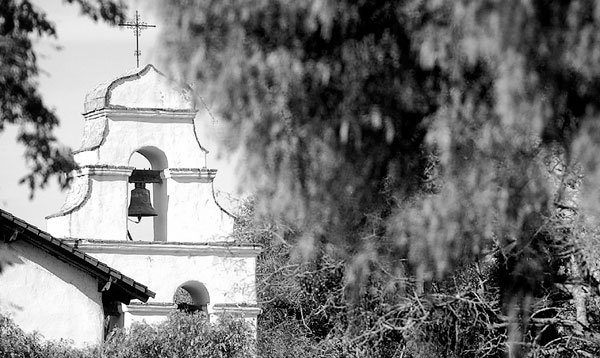The Mission San Juan Bautista evokes both nostalgia and sadness
for the Amah Mutsuns; a site that holds so much of the tribe’s
history, yet has witnessed so much of the suffering in the past
while they lived in its shadow.
The Mission San Juan Bautista evokes both nostalgia and sadness for the Amah Mutsuns; a site that holds so much of the tribe’s history, yet has witnessed so much of the suffering in the past while they lived in its shadow.
The Amah Mutsuns were involved with the mission since its very founding in 1797, according to Tribe Historian Ed Ketchum. When the Spanish arrived in what is now San Juan Bautista to spread Catholicism, they enlisted the help of the natives to build the 15th mission in California and to disseminate their religion throughout the area.
“Since they were the closest to the mission, our families were assimilated fairly early, and as such some of our family members were then part of the people who helped the missionaries go out and get other Indians from the valley,” said Ketchum. “Then when they brought them in it was their job to help assimilate them into the mission.”
But there were many other jobs for the Amah Mutsuns living at the Mission San Juan Bautista. After bells woke them early each morning, they would eat breakfast and then begin following the day’s six scheduled events, according to Leventhal. The day’s events might include mass services, choir or orchestra practice, or working with textiles and tallow, he said. Ketchum added each Indian at the mission was also assigned a special job to perform. This could range from construction, to livestock herding, to tending the vineyards and pear orchards, he said.
“They had to wake up and go to mass really early, then they went out and did all their chores,” Ketchum said.
At the end of the long day, living conditions were poor, Leventhal and Ketchum agreed.
In the 1990s, state archaeologists found traces of what they believed to be Indian family housing at the Mission San Juan Bautista. Archaeologists found evidence of two buildings totaling about 33 native housing units, each about 17 feet by 14 feet with a fire pit in the middle of the floor. Scientists believe the buildings date back to about 1824.
Unmarried young women, though, were locked away in a small building, causing the spread of cholera and measles, Leventhal said. Ketchum said the logic behind this was primarily “keeping the young unmarried women away from the young unmarried men.”
“They were so crowded and the conditions were so bad that some of them died. They said that when they would open the doors to let them out to mass they would just run out the door and gasp for air,” said Quirina Luna-Costillas, an Amah Mutsun living in San Juan Bautista.
In fact, Leventhal said, the average life estimate for a Native American once he or she moved into the mission was only about less than four years.
“The intent was not to make the living conditions bad, but the sanitary conditions were just very poor because they used chamber pots and nobody really understood the spread of disease,” Leventhal said.
In addition, the natives were forced to abandon their customs and assimilate to a totally new way of life, he said.
“There was a disruption of the economy and the ecology and a whole new order was brought on to the tribe,” Leventhal said.
Natives were forced to farm crops that were unfamiliar to the tribe, which had raised only tobacco before the Spaniards arrived.
“These people did not have a need for agriculture. They understood their environment and the resources in their environment well enough to have very large villages (before the Spaniards came),” Leventhal said.
While not completing their chores, he said, the Indians were not allowed to leave the premises without permission, and even then they needed passport-like identification to move about.
About the time of the state-ordered secularization of the California missions in 1834, conditions began to improve slightly for the Amah Mutsuns at San Juan Bautista, Leventhal said.
“With the secularization, the power of the church was essentially broken. The Indians, being familiar now after several generations of being baptized, married and buried by the church, were socialized to maintain relations with this sort of familiar institution,” he said.
But even then, Leventhal said, “the Californian and the Mexican elites looked at the Indians as kind of a labor pool to support their large estates, and the Americans felt that Indians were basically obnoxious to their way of life.”















